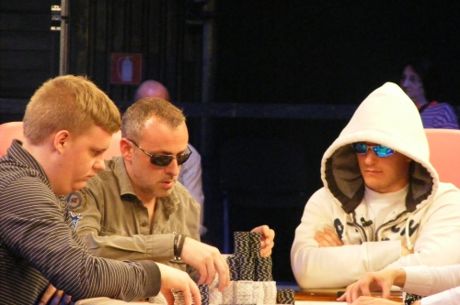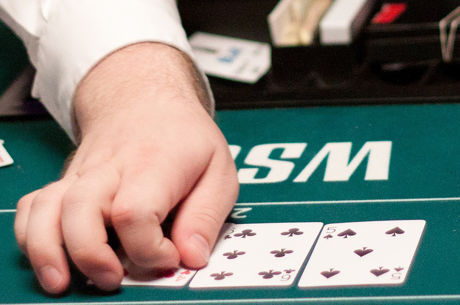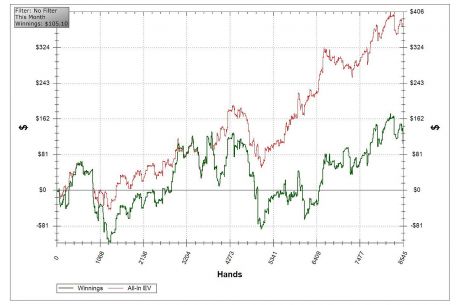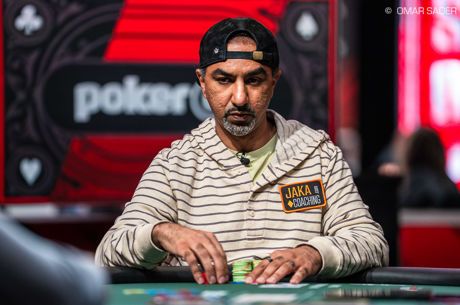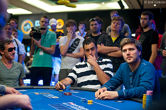Let's Talk About Seven-Way Flops: Range Advantage and Multi-Way Action
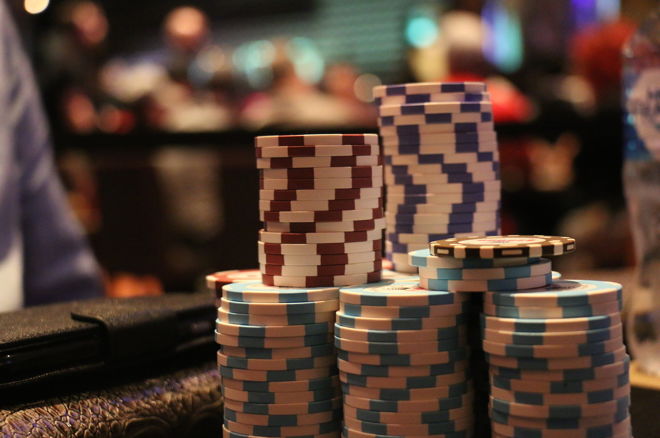
Sometimes after one has observed live poker for an extended period, something happens that causes witnesses to reflect to themselves, "Surely, that has never happened before until now."
I was fortunate enough to see one such hand recently, in Thessaloniki at the Grand Live Poker Tour's final stop of its Season Five tour.
This was a �1,100 buy-in tournament. They'd yet to reach the money, and the blinds were 150/300 with a 25 ante. A heroic Greek player raised to 700 from under the gun, then a young, stoic, and quiet Russian, just called next to act. Five other players then called, including the button �� an older, Swedish recreational player �� and both blinds.
The flop came A?Q?9?.
Where Are We Now?
You may have heard people talking in terms of a "range advantage."
Betting is an inherently profitable action in poker by virtue of how the game is constructed. When someone has a range advantage, we can say that player has an opportunity to make such a bet �� an opportunity to take a profitable action.
For example, when the big blind defends facing a super tight UTG open and the flop comes 4?5?6?, we can say that the big blind might have a range advantage, because the BB can flop everything on this board, whereas the strongest hands a super-tight UTG-opening range might have are 8x8x to AxAx. In this way the big blind can pressure the UTG player by leading out with a bet.
So, who has a range advantage in this seven-way situation?
Only two players could have AxAx �� the UTG player and the man to his left. Everyone else we should presume would have squeezed the action with aces before the flop. Being able to have the nuts isn't always the same as having a range advantage. Think of the 10x9x8x flop for a UTG player who opens 10x10x, QxJx, and 8x8x, but not (say) all the 10x9x, 10x8x, 9x8x, Jx7x, or 7x6x hands with which the BB might defend.
In this spot, however, the only two-pair combination the UTG player cannot have is Qx9x. The player could hold two combinations of Ax9x (if a loose, big stack), and of course can have AxAx, AxQx, QxQx, and 9x9x. Because of this strength, the player might be able to add some bluffs to a betting range, namely the four combinations of Jx10x, and maybe three combinations of KxJx-suited that have the backdoor flush draw.
So we think that the under-the-gun player should be able to bet here, but by no means can the player bet with the entire opening range (e.g, not with 10x10x and not with AxKx). And should the Greek player not bet, the Russian next-to-act might bet, because that player also should have all of the strongest hands on this flop, since he should rarely three-bet before the flop.
If neither of these players bet, I would contend it should check around nearly always.
Principles of Multi-Way Action
Three-way action works a lot differently from heads-up action. Take three players A, B, and C. If Player A is thinking of betting, that player has to worry not just about B and C separately, but the combined strength of B and C's ranges. Then if Player B calls with C left to act, B has to worry about C's range and A's range. When the action goes seven ways, this effect kaleidoscopes as if some hallucinogenic substance were present.
For this reason the initial raiser cannot continuation bet AxKx here. And I mean that both in theory and in practice in the real hand. AxKx simply is not strong enough with six players left to act.
Why? Think of it this way �� what hands does AxKx not want to be called by on this A?Q?9? flop? AxQx, Ax9x, 9x9x, and Qx9x. With six players behind him, the odds that one player has one of these hands is higher than the price our ace-king hero would set himself with a bet.
We could make a case that worrying about those hands is falling prey to monsters-under-the-bed syndrome, if we were heads-up or even three-way. But as N increases where N is the number of players to see the flop, at some point the likelihood someone holds one of those hands becomes better than not. At some point it becomes so probable that betting becomes unprofitable with a range that includes AxKx. More strength is needed.
You might be thinking, well, we can bet and find out where we are at. But we can find out where we are at with AxKx for free �� by checking. Why waste chips on free information?
Curious Flop Action
The player under the gun did bet �� 3,100 into a pot of 5,100, and the player next to act called.
Now think about what we just went over. The player with six opponents bet. The player is saying not just that he has a strong enough range to bet in this situation, but is representing a hand to be one in the range strong enough to do so.
Betting can be profitable in one of two ways �� (1) everyone folds; or, (2) some call and the betting player wins at showdown. The same cannot be said of calling, as an action. And who called? The player with five opponents behind him!
This player is actually in the most precarious position after the initial raiser continuation bets. The caller has no hope but to win at showdown and is taking on all comers.
What range of hands is strong enough for the player to have to make such a call? I contend that Ax9x is borderline. The player second-to-act should snap-fold AxKx.
Really, you say? Let's run through the logic one more time so we can go forward on the same page.
Those better hands �� AxQx, Qx9x, Ax9x, and 9x9x �� are out there. The player calling with five people behind has no assurances that those players don't have those hands. The caller also doesn't have a chance at winning the pot now. The caller is taking on the remaining players' raising ranges and calling ranges, combined, plus the initial raiser's continuation betting range, which is strong enough to be betting into six players. Then the player still has two more streets to get to showdown �� which is far away and a lot could happen.
I don't typically like gendered analogizing in poker, but in this situation ace-nine is a part of the male anatomy and this seven-way flop is a very cold pool.
Relentless Turn Action
Are you interested yet in this hand, or what?
We have two players who are saying they have very strong hands. And guess what, the button called, too. Everyone else folded. To recap, then, we have a UTG raise to 700 at 150/300/25, six calls (!), a flop of A?Q?9?, a continuation bet of 3,100, two calls, four folds, and a turn card of�� the 9?, bringing a full rainbow and pairing the board.
Let's take a moment and think of the hand from the perspective of the Swedish player on the button, who has seen tremendous strength shown by both UTG and UTG+1. What range of hands makes sense for the button to gotten this far with?
I think any combination of Jx10x is the most obvious. Gutshots drawing to the nuts with a backdoor flush draw, KxJx-suited and Kx10x-suited (of which there are only six total combinations), also make sense. This player needs to draw to the nuts, that is, have hands that can pass the strongest parts of his two opponents' ranges.
Remember, both players are saying they have hands in the set of {AxAx, QxQx, 9x9x, AxQx, Ax9x}. So the button needs to fold made hands that don't do well against those hands and call with hands that can draw out against those hands.
The button should therefore quickly fold AxJx, and maybe Ax9x. But K?J? might be a call, because on a 10x turn or a spade-spade runout, the player can stack one or both players some amount of the time, and get a monster return on a 3,100-chip investment.
A Rigid Development
You know those players who open Ax6x-offsuit UTG at a full ring table? At some point this will catch up with them. Meanwhile no amount of poker skill can make Ax6x a profitable open at, say, a twenty-handed table. There is too big a chance someone has a premium hand.
The same logic is going to apply here, on this turn, to our poor player on the button.
The only "made" hands the button can have to continue versus the action with here are Qx9x, Ax9x, and 9x9x (since AxAx and QxQx would have been three-bet preflop). The majority of the button's continuing range on the flop should have been draws to the nuts, namely the 16 combinations of Jx10x that likely get flatted with preflop.
But we see now, on this turn card, that the value of Jx10x, KxJx, and Kx10x is heavily diminished. The board is full rainbow, so backdoor flush draws are down the toilet. And the board has paired, so none of these draws are to the nuts.
A Question of Cleanliness
It isn't just that outs are now "unclean" (as they say) for the button when holding Jx10x. The fact is the button now cannot comfortably call a river bet even when making a straight, much less raise.
In wide-range situations, Jx10x can still possess a high cleanliness factor on this A?Q?9?9? board. Cleanliness means getting paid on a Kx or an 8x river and to what degree, as offset by not going broke to full houses.
But as we have been reiterating, this is not a wide-range situation, but its opposite. Jx10x might have some clean outs versus both opponents' turn-checking range, but those are eight outs versus both players' "turn-putting-money-into-the-pot" ranges �� in fact, those eight in reality might be reduced to zero.
By that I mean this �� if there is a bet and a call in front of the button on this turn, overcalling could be a negative freeroll. The player will never win the pot because the button is already drawing dead, but sometimes will make a straight to lose even more chips on the river. That's how strong ranges should be at this point.
What Actually Happened
The Greek player under the gun, totally undeterred, bet 7,100 into 14,400, and the Russian player next to act �� once again between a hard place and the button �� called. There are very few hands that make sense for either player to play this way and there are very few for the Swede on the button to continue with �� but continue the button did, with a call!
Someone should have a full house or quads at this point in the hand. Whether it is the double-barreling initial raiser (who could have AxAx, QxQx, Ax9x, or 9x9x), the sticky early position caller (who could have AxAx, QxQx, or 9x9x), or the doubly sticky button (who could have Ax9x, Qx9x, 9x9x).
I'll spoil things a bit �� someone had one of these hands. Can you guess which?
Tune in tomorrow and I'll tell you in Part Two, "Carnage and Regret."
Gareth Chantler is a professional poker player, independent writer, and journalist. Follow him on Twitter @GarethChantler, and visit his site Stories from Syria.
Want to stay atop all the latest in the poker world? If so, make sure to get PokerNews updates on your social media outlets. Follow us on Twitter and find us on both Facebook and Google+!

